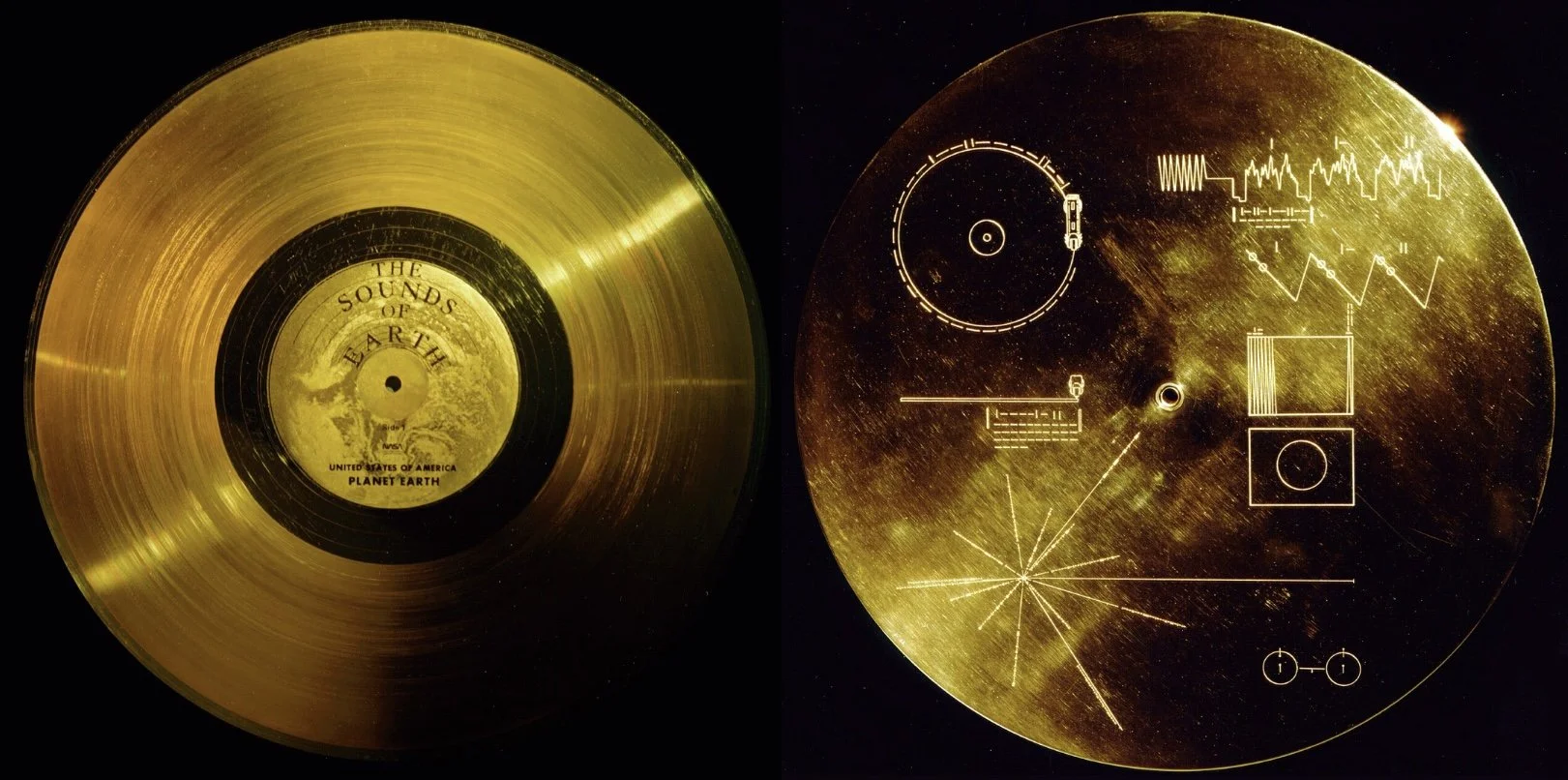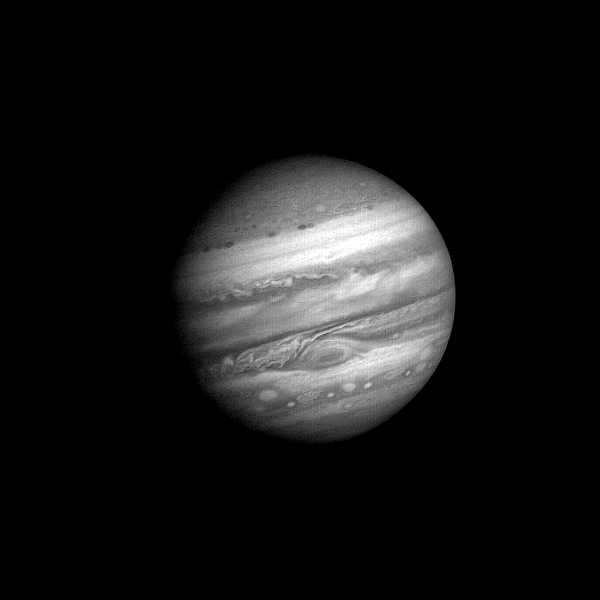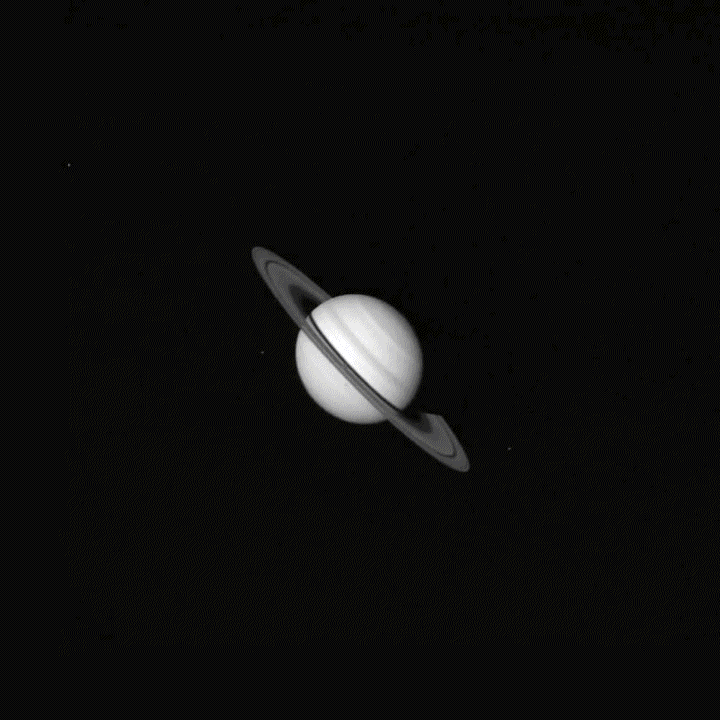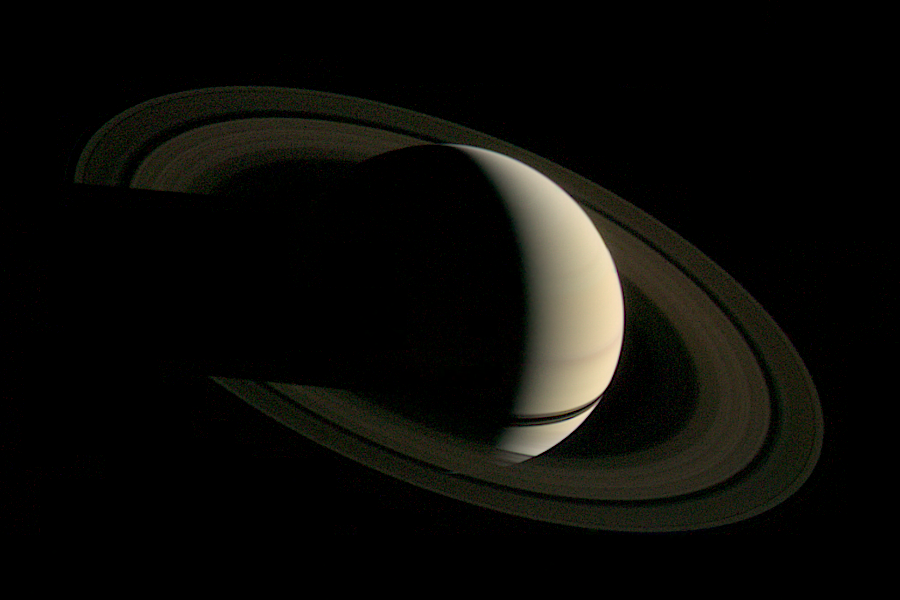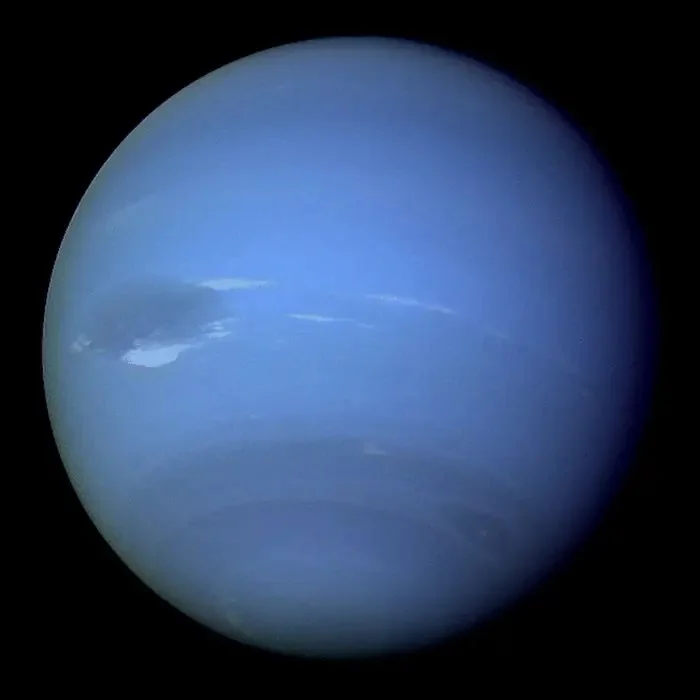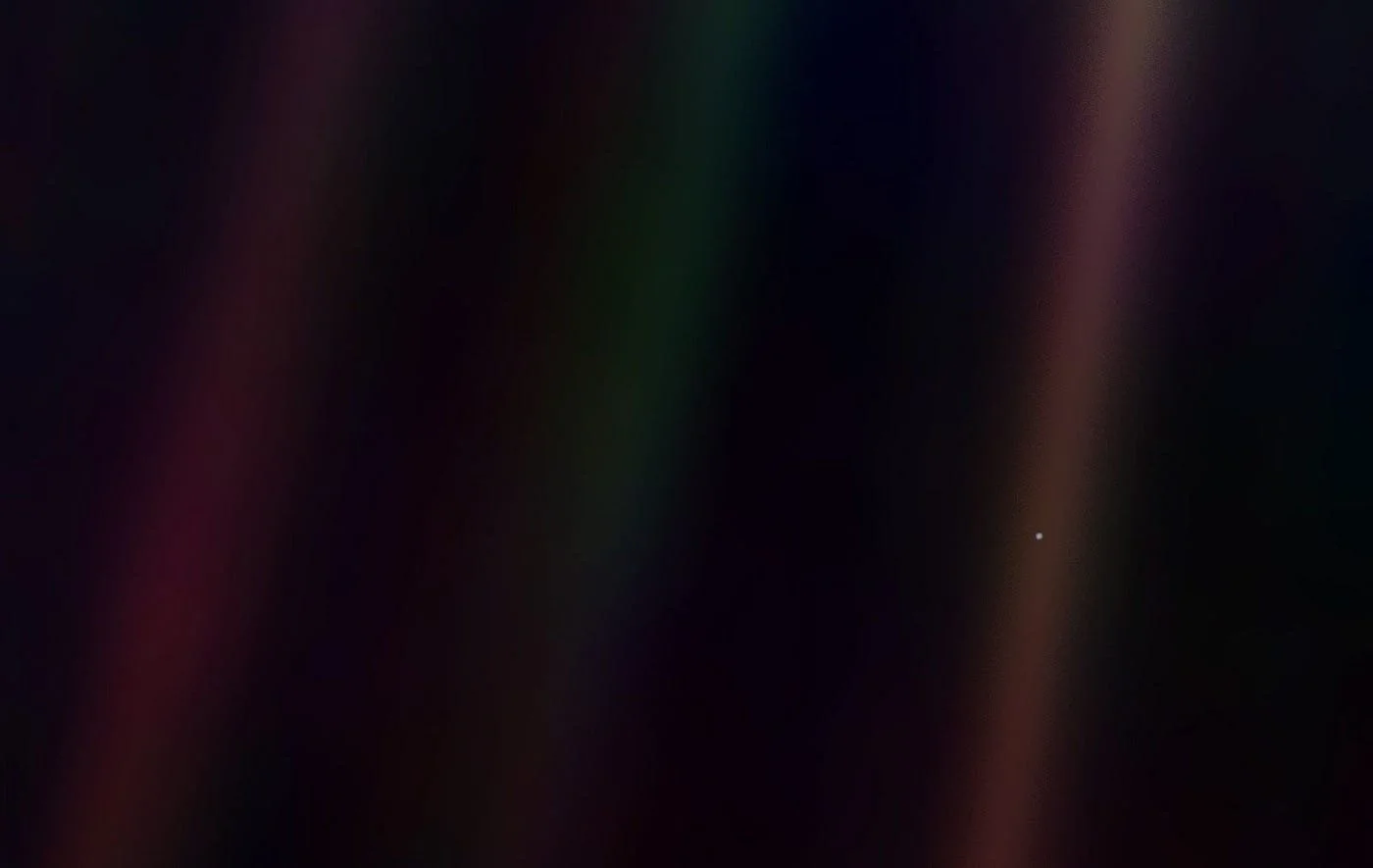The Grand Voyage
by Sam Atkins
In 1977, NASA sent the twin Voyager space probes to explore the outer solar system. Today, those probes are the most distant human-made objects from Earth. What did they find along the way and what does this grand voyage mean for the future of humanity?
THE VOYAGER PROGRAM
The Voyager program was originally conceived as the Grand Tour in 1964 when a relatively rare alignment of the outer planets was predicted to happen in the late 1970’s. It was determined that a series of gravity assists would enable a single spacecraft to visit all four of the gas giants in a single trip. The math showed that this only happened every 175 years so there was an urgency to not allow the opportunity pass unanswered. A version of this idea was developed that would cut down mission time in half by sending two probes instead of one. Unfortunately, the mission’s budget was deemed out of control by Congress and the mission was scrapped in favor of a focus on the Space Shuttle program. The Grand Tour idea was replaced by a more modest goal of visiting only two planets, Jupiter and Saturn, and Saturn’s moon, Titan, using two Mariner-based probes. That being said, the probes would be intended to have the capability to visit Uranus and Neptune but not advertised as part of the primary mission to moderate cost projections. Two trajectories were decided with one probe going to Jupiter, Saturn and Titan while the other would follow as a backup. Should the first probe have succeeded, the second probe would be green lit to continue on with the original Grand Tour and go to Uranus and Neptune. NASA held a competition in March 1977 to rename the program, which became the Voyager mission.
THE VOYAGER PROBES
The Voyager space probes were designed by the Jet Propulsion Laboratory, the legendary creators that would go on to build the Juno spacecraft, the Mars Reconnaissance Orbiter, the Curiosity and Perseverance Mars rovers, and more. Voyager was naturally based on a modified version of the previous Mariner space probes, which were tasked with visiting the terrestrial planets of the inner solar system (Mercury, Venus and Mars).
The probes were built to withstand the extreme conditions of space, such as harsh radiation and vast temperature ranges, that they would endure for decades. They are powered by radioisotope thermoelectric generators which use the heat produced by the radioactive decay of plutonium to generate voltage.
This is all in service to carry the Voyager probes’ suite of science instruments. For starters, they were equipped with two high-resolution cameras, one wide-angle and one narrow angle. They were also equipped with a pair of spectrometers that analyze both infrared and ultraviolet spectra of planetary atmospheres. It is fitted with detectors to measure the solar wind from the Sun and cosmic rays coming from outside the solar system. The long boom extending outward from below the dish carries three spaced-out magnetometers which map the magnitude and direction of the magnetic fields of planets to provide a three-dimensional model.
To transmit these images and data at a high rate, each probe is fitted with a 12-foot wide hi-gain dish antennae which remains pointed directly back at Earth. Flanking both sides of the magnetometer are two low-gain antennas which allow omnidirectional reception of signals to and from mission control.
THE GOLDEN RECORDS
Attached to the side of the housing for the main systems of each Voyager probe is a 12-inch golden phonograph record. As they are humanity’s first and furthest reach into interstellar space, they may one day be the first emissaries to make contact with extraterrestrials on humanity’s behalf, as unlikely as that may be. The etchings on the golden cover (right) are instructions to potential space-faring aliens on how to play the record.
The contents of these records are a wide selection of images and audio files meant to represent the diversity of life and human culture present on Earth. For example, it includes spoken human greetings in 55 different languages, both ancient and modern. It also includes various sounds of nature such as waves crashing on the beach and the chirping of birds, and a selection of 27 songs from across numerous cultures and eras. Some of the songs included are Beethoven’s “Fifth Symphony” and “Hound Dog” by Elvis Presley! Over a hundred images were assembled to demonstrate scientific and mathematical concepts, human biology and civilization, and the natural wonders of Earth including landscapes, plants and animals.
You can hear and see the various contents of the Golden record here: goldenrecord.org
“The spacecraft will be encountered and the record played only if there are advanced space-faring civilizations in interstellar space, but the launching of this 'bottle' into the cosmic 'ocean' says something very hopeful about life on this planet.” — Carl Sagan
THE VOYAGE
Voyager 2 was launched from Cape Canaveral, Florida on August 20, 1977, two weeks ahead of Voyager 1. The reason had to do with their respective trajectories. Both spacecraft were intended to visit Jupiter and Saturn but only Voyager 2 would go on to Uranus and Neptune as well. This would require a longer, more deliberate route to take advantage of the rare planetary alignment that inspired the mission. This involved gravity assist maneuvers that would allow Voyager 2 to hop from planet to planet.
Meanwhile, Voyager 1 was launched on September 5, 1977. Set on a faster, more direct route, it would quickly overtake its twin and be the first to reach both Jupiter and Saturn, providing an in-depth analysis of those planets, as well as Saturn’s largest moon Titan, before shooting off towards interstellar space.
Pictured above is a diagram of the trajectories that enabled NASA's twin Voyager probes to reach all four outer planets and achieve velocity to escape our solar system.
NASA’s YouTube channel has an animation that shows the progression of these paths in three-dimensions:
EARTH & MOON
A few weeks after launch, Voyager 1 sent back this hauntingly beautiful image of the Earth and Moon from a distance of 11.66 million km (7.25 million mi). Voyager 1 was positioned at the zenith directly over Mt. Everest on the Nepal-China border. The dayside of the crescent Earth shows east Asia and the western Pacific Ocean. Beyond Earth, at the top of the image you can see the Moon. Because the Earth is significantly brighter, the Moon had to be artificially brightened by a factor of three in post-processing.
Never before had a picture quite like it been taken. This would be the first of tens of thousands of photos that we would receive in the years to come.
JUPITER
Voyager 1 reached Jupiter, the largest planet in the solar system, on March 5, 1979, about a year and a half after it launched. This was the third space probe to visit the gas giant, following Pioneer 10 and 11 in 1973 and 1974, respectively. Still, the first images taken by Voyager continued to transform our understanding of Jupiter.
Jupiter’s “surface” is a series of beautiful and complex currents that carry distinct light and dark-colored bands that flow along the cloud tops. These tapestries of hydrogen and helium gas are ushered along the width of the planet by its interior convection. Huge storms penetrate through the cloud tops like cavernous swirling craters, yet they too are helplessly carried along like ships adrift in the ocean. There is one storm that dwarfed all the rest. Jupiter’s Great Red Spot, a colossal crimson tempest, is the planet’s most famous feature. It’s a churning vortex so huge it could easily swallow the entire Earth whole, and it has been raging for at least a few hundred years.
Voyager 1 also imaged Jupiter’s four Galilean moons which are each uniquely fascinating objects. The closest of the four moons to Jupiter, Io (upper left), was discovered to be the most geologically active object in the entire solar system, featuring hundreds of active volcanoes and extensive lava flows. Conversely, the smallest Galilean moon, Europa (upper right), was a frozen world split across the surface by stress fractures that suggested it concealed a subterranean ocean. Ganymede (lower left), Jupiter’s largest moon and the largest moon in the solar system, features distinctive rough and smooth surface regions as well as the only known moon to have a magnetic field. The most distant moon to Jupiter, Callisto (lower right), was found to have the oldest and most heavily-cratered surface in the solar system, suggesting it was geologically dead.
Not only did Voyager 1 discover new features about Jupiter's four Galilean moons, but it also discovered two additional moons in interior orbits! Amalthea and Thebe were not as large as their four Galilean sisters but their proximity to Jupiter resulted in some interesting orbital mechanics.
After months of observation, Voyager 1 was leaving Jupiter behind and making its way to Saturn. As it crossed into Jupiter’s shadow, it saw something no human had ever seen before. Jupiter’s rings. Yes, Jupiter was discovered at this point to have a thin ring system. It is less substantive than the rings of Saturn and Uranus, consisting mainly of dust. Voyager 2 managed to get a better image. The ring system would be studied much more closely when the Galileo probe arrived in 1995.
As Voyager 1 was leaving Jupiter in its rearview, Voyager 2 was beginning to photograph its own approach to the gas giant. The probe would follow up on much of Voyager 1’s initial discoveries. It began as soon as it entered into the Jovian system, performing close flybys of the Galilean moons. Most notably, it watched volcanic eruptions in Io, seeing plumes of sulfuric ash reaching as high as 300 km above the surface. Together, the two probes witnessed nine volcanic eruptions on Io. The small moon's proximity to Jupiter makes it vulnerable to the stresses of Jupiter’s strong tidal forces stretching and heating its interior. This is what causes the geological activity. Voyager 2 also found that regions of Io’s surface had been transformed significantly between the two probes' visits, reshaped by the regular outflow of lava.
Voyager 2 also discovered two more moons in interior orbits to the larger Galilean moons, Adrastea and Métis. Asteroid impacts on these moons are believed to be responsible for the dust that forms Jupiter’s thin ring system. Together with Amalthea and Thebes, the Voyager probes had discovered what today we know as the four innermost moons of Jupiter.
Voyager 2 then turned its attention to Jupiter ‘s atmosphere, particularly its Great Red Spot. This colossal crimson tempest, is the planet’s most famous feature. It’s a churning vortex so huge it could easily swallow the entire Earth whole and it has been raging for at least a few hundred years. It takes a week for the 270 mile per hour winds to carry the gas around in a full counterclockwise rotation. It is generally a reddish color, though its hue can shift from a brick red to a pale salmon color. Various hypotheses would arise between scientists in the chemical composition that produces this coloration. Infrared data indicates that the storm is noticeably colder than the rest of the surrounding cloud tops.
The Voyager probes’ magnetometers gathered data from Jupiter’s monstrous magnetic field. Jupiter has the largest and strongest magnetic field of any planet in the solar system, powered by interior metallic hydrogen and its rapid 10-hour rotation period. It dominates a region millions of kilometers out, creating a huge cavity in the solar wind traveling around the gas giant. Much of the matter that pervades the magnetosphere is fed to it by erupted volcanic material from Io, which then interacts with the highly charged particles.
SATURN
A gravitational assist from Jupiter sent both Voyagers on their way to their next destination. Voyager 1 had a good head start, approaching Saturn a year and half later in November of 1980. It was the second probe to make it to the ringed wonder behind Pioneer 11, which had visited Saturn only a month after both Voyager probes had vacated Jupiter.
Saturn’s atmosphere features velvety horizontal bands across the width of its cloud tops, like Jupiter. However, the contrast between them is much more subdued. It’s possible that the hydrogen and helium gasses within them are mixing across the bands, giving Saturn a general brownish-gold color with some regions paler and others darker. The planet gives off a bluer hue near the perimeter where a layer of haze creates a scattering effect.
While the subtle color scheme may suggest Saturn’s atmosphere to be a more serene scene, closer inspection by Voyager 1 told a different story. Earth-sized storm systems driven by the planet’s internal heat pepper Saturn’s cloud tops surrounded by smaller, transient pale storms. The most magnificent storm was found at Saturn’s northern pole, a hexagonal storm measuring 30,000 km across. Unfortunately, the trajectory of the Voyager probes only allowed tantalizing glimpses of the polar storm’s edges. We would have to wait another 24 years for the famous Cassini space probe to capture detailed images from a desirable vantage point.
Saturn was originally thought to have five major rings. Upon close inspection with Voyager 1’s hi-res cameras, it was discovered that those rings were made up of hundreds of thin ringlets. These are countless icy particles that coalesce into strands of varying thickness. Some are as thin as a few meters wide while others stretch across several kilometers. However, these sizes big and small pale in comparison to the grander scale of the main rings which span two-thirds the distance between the Earth and Moon. You could say these ringlets resemble the grooves on a vinyl record, except these are subject to the complex forces of numerous other rings and moons moving all around them.
Voyager 1 also discovered an additional ring! There are the main rings that we all recognize in most pictures of Saturn which are A, B, and C-ring. There are a few really thin rings, D and F, interior and exterior to those rings, respectively. Then there is the E-ring which is the faintest ring of the whole system. It was only discovered due to its incredibly broad size, covering a vast area around Saturn almost 200,000 km across. Voyager 1 discovered the G-ring, which sat between the inner main rings and the diffuse outer E-ring. The G-ring was the perfect middle ground between the thinness and defined boundaries of the D and F-rings and the breadth and haziness of the E-ring.
We also got a much closer look at the thin, outer F-ring, discovered only a year prior by the Pioneer 11 space probe. It was found to be multi-stranded and unkempt, like a twisted up guitar string. Another surprise in the F-ring was the discovery of two small shepherd moons, Prometheus and Pandora, which guide the rings along with their own gravity.
We also learned that Saturn is gradually losing its rings. The gas giant’s strong gravity is slowly pulling the icy particles to spiral inward, creating a kind of dusty rain showering down on the cloud tops. Don't fret! This is happening in astronomical time periods. NASA estimates that the rings could be gone within 300 million years.
When the Voyager mission was being planned, a choice had to be made. Voyager’s trajectory could allow it to visit Saturn’s largest moon, Titan, or visit what was considered to be the ninth planet at the time, Pluto. Images taken of Titan by the previous space probe to visit Saturn, Pioneer 11, captured scientists’ attention and begged for a closer look. Voyager 1 set its sight on Saturn’s largest moon.
Why so interested in a moon more than a planet? It is because Titan is the only known moon to have a thick atmosphere. In fact, the atmosphere is so thick that we can’t even see the surface of the moon through it. We originally thought Titan was the largest moon because its atmosphere was inflating its perceived size. In reality, Ganymede is slightly larger.
Spectral analysis indicated that while the composition varied with altitude and latitude, nearly all of Titan’s atmosphere was composed of nitrogen with trace amounts of methane and other gasses. The atmosphere’s yellow-orange hue is attributed to the abundance of complex organic compounds called tholins (these are also responsible for the dark hues found in the surface of Pluto). Methane constantly cycles between a liquid and gas. Yes, it rains liquid methane on Titan and the surface is covered in liquid lakes and rivers of methane and other hydrocarbons. However, this was merely deduced by Voyager 1 via radar imaging. We didn’t get real photographs of the surface until the Cassini probe and the Huygens lander investigated the moon in the mid-2000’s.
As Voyager 1 passed Saturn, its primary mission was about wrapped up. The space probe took a sharp turn upward, its new trajectory rising above the orbital plane of the solar system. Voyager 1 would continue out toward the vastness of interstellar space for the rest of its days.
We will catch up with Voyager 1 a little later. In the meantime, Voyager 2 was soon to arrive at Saturn for its own turn.
Voyager 2 had started observations of Saturn in June of 1981, taking images from 41 million miles away. It reached the Saturnian system on August 22, 1981, a full nine months after Voyager 1 flung itself out from the solar system.
It picked up where Voyager 1 had left off, conducting investigations into, among other things, Saturn’s moons. For example, the Voyager probes found that Saturn’s moon Enceladus and Jupiter’s moon Europa have a lot in common. Like Europa, Enceladus was found to be one of the more active bodies in the solar system. This was indicated by stress cracks and smoothed plains across the surface. Something was applying pressure to the icy crust from below and spilling more ice across the surface to cover up impact craters. On both moons, the Voyager probes observed huge plumes of salt water, escaping into space as if from a geyser.
All of this evidence pointed to one thing shared between both moons. In all likelihood, they each have a subsurface ocean of water. The implications of this are profound. Not that we have the greatest sample size of the universe to work with, but so far the presence of liquid water seems to be a prerequisite for life.
Could there be that we’ve been looking far to the stars for potential life when it may exist in our very own backyard? Could microorganisms below the icy surface of these moons be possible? The Voyager probes gave us a scent to track down the answer that would influence future missions to Saturn.
Voyager 2 made its closest approach to Saturn, in part to use the planet’s gravity as a speed boost to launch it towards Uranus. While it made its pass, the probe used radio beams to penetrate and gather data on the planet’s atmospheric temperatures and pressures at different depths, noticing it was colder at the poles than at the equator at comparable pressures.
It also continued investigations into Saturn’s rings. Both Voyager probes found that the rings featured irregular dark spots across the main ring system’s plane, like spokes on a bicycle wheel. These spokes appeared dark against the brightly reflected rings, but appeared bright when the rings were not reflecting sunlight. This indicates they scatter reflected light more efficiently in a forward direction.
By staring through the rings at background stars, they could look for interruptions in the stars’ brightness to indicate just how empty these gaps between them really were. They did find that, in almost every case of a clear gap, they were occupied by very small, eccentric ringlets of material. As said before, it is believed that undiscovered moons around or within the ring system could be influencing their behavior (hence why they are referred to as shepherd moons).
As its twin barreled out into the great beyond, Voyager 2 was not finished yet. It set its sights on the other half of the outer planets, the ice giants. First up to bat was Uranus. Due to its much greater 3 billion km distance from the Sun, it would take five years for Voyager 2 to reach the seventh planet.
URANUS
Voyager 2 arrived at the Uranian system at the beginning of 1986, making its closest approach on January 24 at a distance of 50,600 miles above the planet’s cloud tops.
One of the starkest differences Uranus has from Jupiter and Saturn is its color. Spectroscopy indicates that the planet’s atmosphere is made up primarily of hydrogen and helium, like they are, but it has a much higher ratio of compounds such as methane and water. These are considered a type of compound called icy volatiles, meaning they easily change states between gas, liquid and solid under changes in pressure and temperature. This is distinct from the hydrogen and helium found in Jupiter and Saturn which remain in a gaseous state under most conditions. The abundance of these “ices” eventually led scientists to reclassify Uranus and Neptune as ice giants.
A byproduct of the extra methane in Uranus’ atmosphere is that methane tends to absorb more red light and reflect more blue light. This is what accounts for the planet’s pale cyan hue. Methane condensation also formed faint patterns of hazy cloud bands.
Voyager 2 was also able to confirm what observations had suggested for years. Uranus is tilted completely on its side. This has interesting effects in the atmosphere as the poles are no longer perpetually pointed away from the Sun. Here, they undergo an extensive 42-year-long season of constant and direct summer sunlight and another 42-year-long season of constant winter darkness. This causes extremes in temperatures on a planet that is already known as the coldest.
While they are very dark and faint, Uranus has a ring system like all the other giant planets. A small number of astronomers had claimed over the years to have seen them through telescopes but it would have been incredibly difficult. They are more substantial than that of Jupiter and Neptune but nowhere near as much as Saturn.
Voyager 2 thoroughly investigated these elusive halos to find out what made them different. The rings were studied through radio and ultraviolet emissions as well as using occultations to discern their general structure. They were observed from different vantage points to see how the sunlight interacted with them at various angles. Voyager 2 observed nine rings that were already confirmed in 1977 as well as discovering two additional ones and two shepherd moons, Cordelia and Ophelia!
In general, the ring particles have an extremely low albedo, meaning they reflect a very small amount of light that reaches them. They may be composed of water ice mixed with dark organic molecules like the tholins found in Titan’s atmosphere. The rings are thin, usually no more than a few kilometers wide, and contain very little dust except some interspersed around the main rings. Their origins were likely from the fragmentation of colliding moons in the relatively recent past (no more than 600 million years old).
Voyager 2 extensively imaged the Uranian systems five major moons, all named after Shakespearean characters. The biggest surprise was the largest moon, Miranda. Scientists were expecting to find a small, boring, cratered world that was geologically dead. Instead, they found a bizarre and chaotic geography. The surface expressed incredible contrasts between heavily-cratered against young and rugged ice landscapes. Chevron-shaped ridges and deep canyons abound. The cliffs on Miranda are among the tallest in the entire solar system, with some reaching twice the height of Mount Everest. These dramatic landscapes hinted at tectonic activity that reshaped the surface. It could be a result of Miranda’s eccentric orbit causing tidal forces from Uranus to cause chaos in the moon’s interior.
Voyager 2 also discovered 11 new smaller moons around Uranus!
Alas, due to the gravitational requirements of its outbound trajectory, Voyager 2 visit to Uranus was the shortest of the four planets. The encounter lasted only a few hours as the space probe flew by. Regardless, a lot of data was collected and today provides us the only close look at Uranus we’ve ever had. While many have begged for a return mission, none have been approved and Voyager 2 remains the only craft to have ever visited the seventh planet. Here’s hoping the idea gains more traction as humans continue to take bolder steps towards solar system exploration.
Voyager still had one more venue on its tour. Uranus’ gravity gave the space probe a speed boost to head straight for Neptune.
NEPTUNE
Three and a half years after departing from Uranus, Voyager 2 reached the second ice giant, Neptune. Like the seventh planet, Neptune is more abundant in icy volatiles, such as methane, than Jupiter and Saturn which gives it its blue color. Despite some popular images of Neptune that have circulated for years, Neptune’s color is not nearly as distinct from Uranus as is commonly believed. Neptune does have a slightly deeper blue color due to Uranus being shrouded by a thick aerosol haze around its cloud tops which make it paler. Most of the confusion comes from certain filters that Voyager 2 used when photographing the planet in order to accentuate certain surface features.
One of the most striking features discovered by Voyager 2 was Neptune’s Great Dark Spot, a massive storm that is very reminiscent of Jupiter’s Great Red Spot. It is roughly the size of Earth appearing as a dark bluish-black oval surrounded by bright, wispy clouds.
The wind speeds clocked by Voyager 2 in this storm were as high as 2,100 km per hour (1,300 miles per hour) at its edges, the fastest ever in the solar system’s recorded history. While this spot is often still associated with the planet today, the spot disappeared back in 1994. However, new dark spots have since taken its place and seem to last up to six years.
Thanks to Voyager 2, Neptune is well-known for its incredibly strong and persistent winds. These are among the fastest winds observed in the solar system, reaching high speeds of over 1,200 miles per hour (2,000 km per hour). This is 1.5 times the speed of sound! Even Earth's most powerful winds hit only about 250 miles per hour (400 kilometers per hour).
The winds of Neptune can be three times stronger than Jupiter’s and nine times stronger than Earth’s. This is strange for a number of reasons:
1. Jupiter is much more massive than Neptune by a factor of 18. More massive planets tend to have stronger winds.
2. Jupiter’s larger mass should also give it more internal heat to drive stronger winds.
3. Jupiter rotates faster than Neptune. It makes a full rotation in just 10 hours while Neptune takes 16 hours.
4. Jupiter receives more energy from the Sun due to its closer distance of 778 million km vs Neptune’s 4.5 billion km.
So why are the winds of Neptune so strong?
There is one thing about Neptune’s stronger winds that do seem to track. The colder gases of Neptune have lower viscosity, meaning they are more resistant to deformation. There’s very little to slow down the winds and act as a source of drag. Also, you don't need to feed the winds much energy to get them going and keep them going. Neptune seems to have hit a sweet spot of relatively large (good for angular momentum), relatively fast rotation (also good for angular momentum), strong internal heat source (good for feeding the winds), and very cold (low viscosity, so little to slow the winds down).
Regardless, the cause of the strong winds of Neptune have perplexed scientists for years and is a hotly debated subject. Unfortunately, Neptune is 4.5 billion km away and Voyager 2 remains the only spacecraft to ever visit it. If we could get another space probe into perpetual orbit around Neptune like we have with Jupiter and Saturn, we could learn so much more about this fascinating ice giant. However, no such plans have been confirmed.
Of the 14 moons of Neptune, Triton is by far the largest and comprises 99% of the combined mass of Neptune’s moons. This frozen, rocky world is covered in nitrogen and carbon monoxide frost that reflects most sunlight that reaches it, cratered and ridged landscapes that resemble the surface of a cantaloupe. The world is incredibly cold at -235°C.
The moon also has geysers that spew nitrogen gas out into plumes that can reach eight kilometers high. You can see them in the image above appearing as various dark streaks across the top. The gas disperses across the planet forming an atmosphere that is thin but not so thin that it can’t form clouds. At the bottom you can make out the cantaloupe terrain.
Triton is the only large moon in the solar system that orbits in the opposite direction of its planet’s rotation. This is known as a retrograde orbit. This peculiarity has led scientists to believe that Triton is not native to Neptune but was once a Kuiper Belt object, like Pluto, that passed too close and got captured by Neptune’s gravity.
Triton’s retrograde orbit also spells doom for this frozen world. Neptune is gradually pulling it closer and closer. When it reaches a certain point, Neptune’s gravity will tear the moon to pieces. All the debris will likely spread out and form a new Neptunian ring system not unlike Saturn’s.
The date was February 14, 1990. Voyager 1 had left Earth behind almost twelve and a half years ago and left Saturn behind over nine years ago. The space probe had traveled approximately 6 billion km from Earth, which is about the average orbital distance of Pluto from the Sun.
The famous and beloved science educator, Carl Sagan, who was one of the people in charge of putting together the messages from Earth included in the Golden Records, convinced NASA to turn Voyager 1 around to take one last look at our home. The probe captured the very first “family portrait” of our solar system including the Sun and six planets (Venus, Earth, Jupiter, Saturn, Uranus and Neptune). Even more famous was one of the individual photographs contained within this portrait. The image of Earth became known as the “Pale Blue Dot,” a humbling reminder of our place in the cosmos. Carl Sagan spoke of this photo at length with a famous monologue with the same title.
“Look again at that dot. That's here. That's home. That's us. On it everyone you love, everyone you know, everyone you ever heard of, every human being who ever was, lived out their lives… on a mote of dust suspended in a sunbeam.” - Carl Sagan (1994)
You can listen to his monologue on carlsagandotcom’s YouTube channel here:
WHERE ARE THEY NOW AND WHERE ARE THEY GOING?
Today, the two space probes are gliding further and further into interstellar space.
The Voyager 1 space probe passed out of the heliosphere, where the Sun’s solar wind dominates, and into interstellar space on August 25, 2012. It was the first human-made object to do so and is currently the farthest human-made object from Earth at a distance of 24 billion km from Earth, which is about four times the distance of Pluto. It takes a radio signal 22.5 hours to reach Voyager 1 from Earth, which goes to show you just how unbelievably fast light is. However, as far as Voyager 1 is, it still has only traveled 0.0024 light years!
At its current speed of 38,200 mph (or almost 11 miles per second), it is expected to maintain that accolade unless some much faster spacecraft is built, launched and catches up to it. The space probe’s trajectory is towards the constellation Ophiuchus, though more specifically, it’s moving toward the solar apex, which is the direction the Sun is moving relative to nearby stars.
In about 300 years, Voyager 1 is expected to reach the innermost boundaries of the proposed Oort cloud, an incredibly vast shell of icy chunks believed to surround the solar system, and will take another 30,000 years to exit it. This would be the furthest possible extent that the solar system can be defined to reach. If it were traveling in the right direction, it wouldn’t reach the next closest star, Proxima Centauri, for another 70,000 years!
Voyager 2 entered interstellar space on November 5, 2018. It is about 18 billion km from Earth, about three times the distance of Pluto, which makes it the second farthest human-made object from Earth. It is currently moving at a speed of about 34,400 mph (or almost 9.5 miles per second) in the direction of the southern constellation, Pavo the Peacock.
Despite their age and distance, both Voyager probes are still operational and still in contact with Earth. They are starting to show serious wear and tear, especially considering the recent string of communication and thruster issues in recent years, and their future remains uncertain. Currently, NASA’s most optimistic estimates have the Voyager probes possibly making it into 2030’s but more conservative predictions are only a few more years.
To be fair, it’s honestly incredible that they have been maintained this long and engineers are able to fix software issues remotely from billions of kilometers away. Remember that these machines were launched from Earth just eight years after the Apollo 11 moon landing! We’ve gotten way, way more out of them than I think anyone ever dreamed of. The Voyager program took us from being an interplanetary species to an interstellar one, just 55 years after the first ever artificial satellite went into Earth orbit. Imagine what humans will accomplish in another 55 years. Luckily, we aren’t done. We are getting more ambitious, technology is advancing, but most importantly space exploration is becoming cheaper! We just need to have the will to do it. Until that next great leap forward, let’s all give thanks to Voyager who helped pave the way.
“Voyager did things no one predicted, found scenes no one expected, and promises to outlive its inventors. Like a great painting or an abiding institution, it has acquired an existence of its own, a destiny beyond the grasp of its handlers.”
Stephen J. Pyne
“Perhaps the records will never be intercepted. Perhaps no one in five billion years will ever come upon them. Five billion years is a long time. In five billion years, all human beings will have become extinct or evolved into other beings, none of our artifacts will have survived on Earth, the continents will have become unrecognizably altered or destroyed, and the evolution of the Sun will have burned the Earth to a crisp or reduced it to a whirl of atoms.
Far from home, untouched by these remote events, the Voyagers, bearing the memories of a world that is no more, will fly on.”
Carl Sagan



